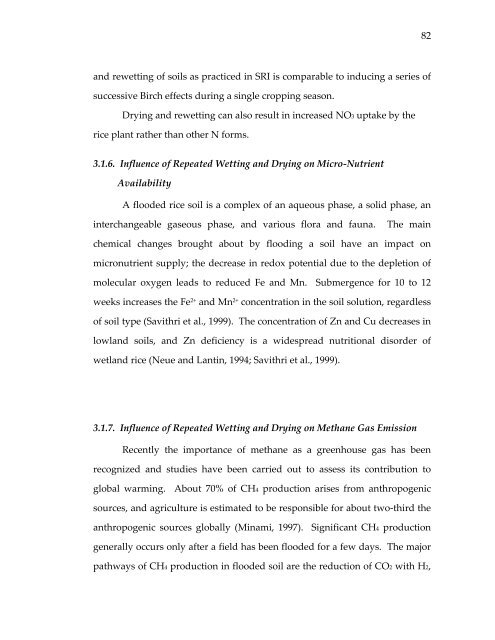Management of rice production systems to increase productivity
Management of rice production systems to increase productivity
Management of rice production systems to increase productivity
Create successful ePaper yourself
Turn your PDF publications into a flip-book with our unique Google optimized e-Paper software.
and rewetting <strong>of</strong> soils as practiced in SRI is comparable <strong>to</strong> inducing a series <strong>of</strong><br />
successive Birch effects during a single cropping season.<br />
Drying and rewetting can also result in <strong>increase</strong>d NO3 uptake by the<br />
<strong>rice</strong> plant rather than other N forms.<br />
3.1.6. Influence <strong>of</strong> Repeated Wetting and Drying on Micro‐Nutrient<br />
……..Availability<br />
A flooded <strong>rice</strong> soil is a complex <strong>of</strong> an aqueous phase, a solid phase, an<br />
interchangeable gaseous phase, and various flora and fauna. The main<br />
chemical changes brought about by flooding a soil have an impact on<br />
micronutrient supply; the decrease in redox potential due <strong>to</strong> the depletion <strong>of</strong><br />
molecular oxygen leads <strong>to</strong> reduced Fe and Mn. Submergence for 10 <strong>to</strong> 12<br />
weeks <strong>increase</strong>s the Fe 2+ and Mn 2+ concentration in the soil solution, regardless<br />
<strong>of</strong> soil type (Savithri et al., 1999). The concentration <strong>of</strong> Zn and Cu decreases in<br />
lowland soils, and Zn deficiency is a widespread nutritional disorder <strong>of</strong><br />
wetland <strong>rice</strong> (Neue and Lantin, 1994; Savithri et al., 1999).<br />
3.1.7. Influence <strong>of</strong> Repeated Wetting and Drying on Methane Gas Emission<br />
Recently the importance <strong>of</strong> methane as a greenhouse gas has been<br />
recognized and studies have been carried out <strong>to</strong> assess its contribution <strong>to</strong><br />
global warming. About 70% <strong>of</strong> CH4 <strong>production</strong> arises from anthropogenic<br />
sources, and agriculture is estimated <strong>to</strong> be responsible for about two‐third the<br />
anthropogenic sources globally (Minami, 1997). Significant CH4 <strong>production</strong><br />
generally occurs only after a field has been flooded for a few days. The major<br />
pathways <strong>of</strong> CH4 <strong>production</strong> in flooded soil are the reduction <strong>of</strong> CO2 with H2,<br />
82
















